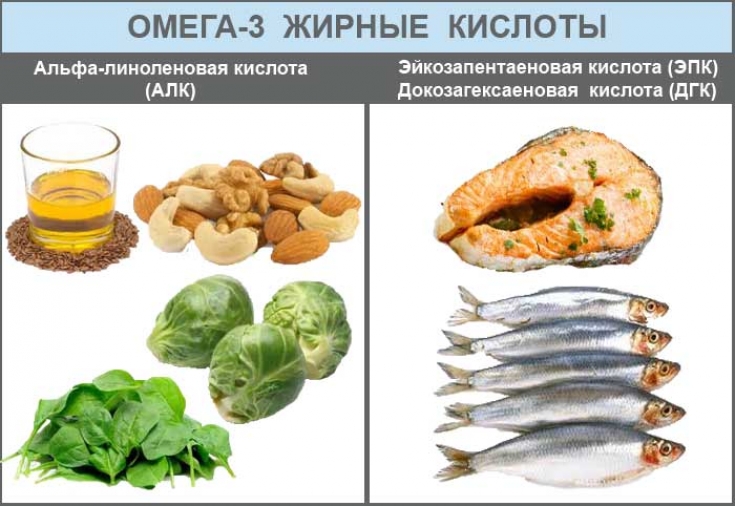What are the mysterious "omega 3s" that are mentioned every now and then in almost any advertisement for seafood? Perhaps this is a new find of smart marketers trying to impose on us the consumption of not the cheapest and most popular product? But why then do nutritionists strongly recommend eating foods rich in omega 3 fatty acids? What is their role in the body? Which foods contain the most? Are there analogues that can replace expensive products containing substances that have become so popular? We propose to find the answer to these very topical questions together with estet-portal.com.
Mute theory: what are unsaturated fatty acids
Fatty acids are part of fats, they serve as a kind of links from which (along with other organic compounds) molecules of fats are built. Molecules of polyunsaturated fatty acids (omega 3, 6 and 9) differ primarily in the presence of double bonds between hydrogen atoms, and the number (3, 6 or 9) shows the position of such a bond in relation to the carbon atom (carboxyl group). Unlike saturated fatty acids, they cannot be synthesized in the human body and must be supplied from outside. Among them, the most important for us are alpha-linoleic, eicosapentaenoic (EPA), docosahexaenoic (DHA).
However, for us, ordinary people who opened a chemistry textbook in high school, such information practically does not explain the increased attention to these chemical compounds. What is special about them?
Why omega 3 fatty acids are especially important
Attention to the notorious omega 3 was attracted by the discovery, which was carried out in the seventies of the last century. Scientists noticed that the indigenous people of Greenland, whose diet was based on ocean fish, were particularly healthy. In the indigenous population of the peninsula, there were practically no diseases of the cardiovascular system, and the vessels were not subject to atherosclerotic changes. The whole secret is that it is in cold-water varieties of fish that the highest content of omega 3 fatty acids is observed. Further studies have confirmed that a diet containing sufficient amounts of unsaturated fatty acids allows:
· prevent coronary disease, arrhythmia;
· reduce the risk of heart attack and stroke;
· prevent visual acuity loss;
· normalize the work of the central nervous system;
· increase immunity, prevent the development of allergic reactions;
· normalize metabolic processes;
· improve the condition of skin, hair and nails.
· improve the condition of skin, hair and nails.normalize metabolic processes;
· improve the condition of skin, hair and nails.
Scientists observe a link between a person's tendency to depression, as well as some mental disorders with a lack of omega 3 fatty acids in his body.
Interaction and balance of polyunsaturated fatty acids
In addition to omega 3, omega 6 and omega 9 fatty acids are also involved in the construction of lipids. All of them have a specific effect on the processes occurring in the human body. In particular, omega 6 fatty acids have an effect on blood viscosity. In addition, omega 6s are necessary in order to improve skin condition and normalize cholesterol levels. Omega 6 polyunsaturated fatty acids we consume together with:
· eggs;
· poultry meat;
· bread and other pastries;
· & nbsp;legumes;
In addition, an excess of omega 6 can lead to an exacerbation of inflammatory processes.
Nutritionists insist on optimizing the balance of omega 3 and omega 6 fatty acids, which ideally should be ingested in a ratio of 4: 1, when four parts of omega 3 fatty acids acids should account for only one part of omega 6. Alas, achieving such an ideal is not so easy, because it means a significant revision of your culinary preferences.
How to fix the situation: adjusting the diet
So what do you do to make sure your body is getting enough of the much-needed omega 3s? Also, how to define this measure?
Of course, seafood manufacturers do not forget to emphasize in their commercials that their products are rich in omega 3 fatty acids. However, one should not think that in order to replenish these substances, you need to include exotic and expensive seafood in your diet every day. It is enough to eat oily sea fish twice a week. Nutritionists recommend giving preference to salmon, trout, tuna, sea bass or mackerel.
Specialists have found that 1 g of omega 3 is absorbed from 50 g of fish. To maintain a normal balance of polyunsaturated fatty acids, 300 — 400 g of fish per week.
Alternative sources of polyunsaturated fatty acids
Fortunately, the inhabitants of the deep sea — are not the only suppliers of valuable polyunsaturated acids. There are some other foods that can serve as a source of omega 3. First of all, flaxseed
Nutritionists recommend eating a handful of nut kernels daily. It is better to do this at breakfast or use nut kernels as a light, but very high-calorie snack.
And of course, do not forget about vitamin complexes, the intake of which helps to correct the lack of certain substances in emergency cases. For example, it could be fish oil, well-known to older people, which, fortunately, is now available in the form of convenient gelatin capsules. However, before going to the nearest pharmacy for a new vitamin complex, it makes sense to consult a doctor who will give you recommendations on the doses and duration of taking the pharmacy drug.
A healthy lifestyle, which is inconceivable without a rational, & nbsp; balanced nutrition has become a real trend of modern fashion. Fortunately, nature has taken care of our health, because all the substances necessary for the body are present in simple and affordable foods that we eat every day. All that is required of us — it's only make the right choice in favor of what we really need.
For more up-to-date information on a healthy lifestyle and a balanced diet, visit estet-portal.com.






Add a comment